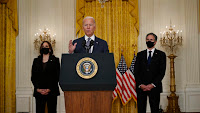President Joe Biden speaks about the evacuation of American citizens, SIV applicants and vulnerable Afghans in the East Room of the White House, Friday, Aug. 20, 2021. From left, Secretary of Defense Lloyd Austin, Vice President Kamala Harris, Biden, Secretary of State Antony Blinken and White House national security adviser Jake Sullivan. | Manuel Balce Ceneta/AP Photo |
With help from Oriana Pawlyk, Daniel Lippman and Lara Seligman Welcome to National Security Daily , POLITICO’s newsletter on the global events roiling Washington and keeping the administration up at night. I’m Alex Ward, your guide to what’s happening inside the Pentagon, the NSC and D.C.’s foreign policy machine. National Security Daily arrives in your inbox Monday through Friday by 4 p.m.; subscribe here. Aim your tips and comments at award@politico.com and qforgey@politico.com. Follow us on Twitter at @alexbward and @QuintForgey. By the morning of Wednesday, Aug. 11, the Afghan government’s already brittle control of the war-torn country was quickly unraveling in the face of a swift Taliban offensive coinciding with the nearly complete withdrawal of U.S. troops that President JOE BIDEN ordered in April. Most of America’s top diplomats and generals were still operating under the assumption that they had ample time to prepare for a Taliban takeover of the country — it might even be a couple of years until the group was in a position to regain power, many thought. Though some military officials and intelligence agencies had stepped up their warnings about the possibility of a government collapse, officials felt confident about the Afghan security forces’ strategy of consolidating in the cities to defend the urban population centers. The president and his top aides still had one more meeting scheduled for Wednesday evening — a pre-planned session on a classified national security matter. As word of the deteriorating situation flowed into the Oval Office that morning, Biden ordered that the early evening meeting should focus on Afghanistan. Sitting in the Situation Room were Vice President KAMALA HARRIS; Defense Secretary LLOYD AUSTIN ; Joint Chiefs Chair Gen. MARK MILLEY; Joint Chiefs Vice Chair Gen. JOHN HYTEN; National Security Adviser JAKE SULLIVAN and his deputy JON FINER; Director of National Intelligence AVRIL HAINES; chief of staff RON KLAIN ; Deputy CIA Director DAVID COHEN; LIZ SHERWOOD RANDALL, the president’s homeland security adviser; and other White House and national security staff. Secretary of State ANTONY BLINKEN participated by phone. Events were growing so dire that the president ordered Austin and Milley to prepare a plan for deploying additional troops to the region, where they would reinforce those put on standby months earlier to evacuate American personnel. Biden also directed the State Department to expand the evacuation of Afghan allies — those who had worked with the Americans and were now in mortal danger — to include the use of military aircraft, not just chartered civilian planes. And he also asked his intelligence officials to prepare an up-to-date assessment on the situation in Afghanistan by the following morning. After the meeting broke up, a classified email was sent to pertinent staffers to convene at 7:30 a.m. the next day. The email went out so late that the Situation Room staff also started calling those aides to make sure they would be on time. That Thursday morning, Sullivan was in the Situation Room with other White House staff while Cabinet members participated via secure hookups. The principals meeting kicked off with an intelligence briefing concluding that the situation was so “fluid” that the Afghan government’s seat of power in Kabul could fall “within weeks or days,” an official noted. Austin recommended that Biden send in troops to evacuate the embassy and protect the main international airport in Kabul. Sullivan asked each Cabinet member in the meeting to weigh in. They unanimously agreed. That was the “Oh, shit” moment, said a U.S. official. It was now officially a crisis. Sullivan walked into the Oval Office just before 10 a.m. to report to the president. Biden picked up the phone and told Austin to send troops to Kabul’s airport. Read POLITICO’s full tick-tock on how the Biden administration handled the collapse of Afghanistan, featuring Alex’s reporting, here. |
|
From reproductive rights to education, Afghan women fear losing progress made in the past 20 years.
Afghan Women Say They Fear for their Jobs and Daughter’s Futures
Women mistrust Taliban promises and many have already closed businesses and deleted social media. →
|
 |
WorldAbdul Ghani Baradar, a founding father of the Taliban, returns homeWill the former military commander and political deal-broker’s influence last in the new Afghan administration? AUGUST 20, 2021 by Amy Kazmin |
|












